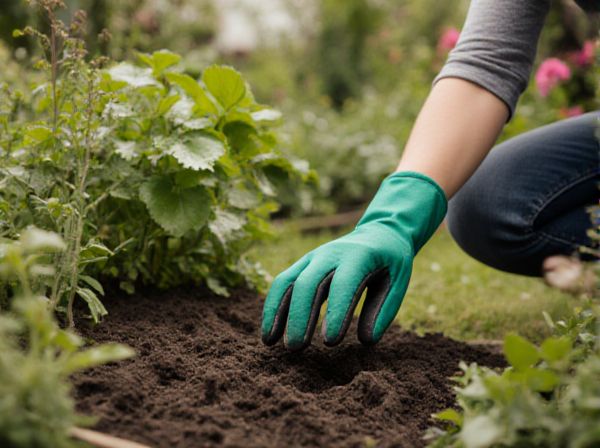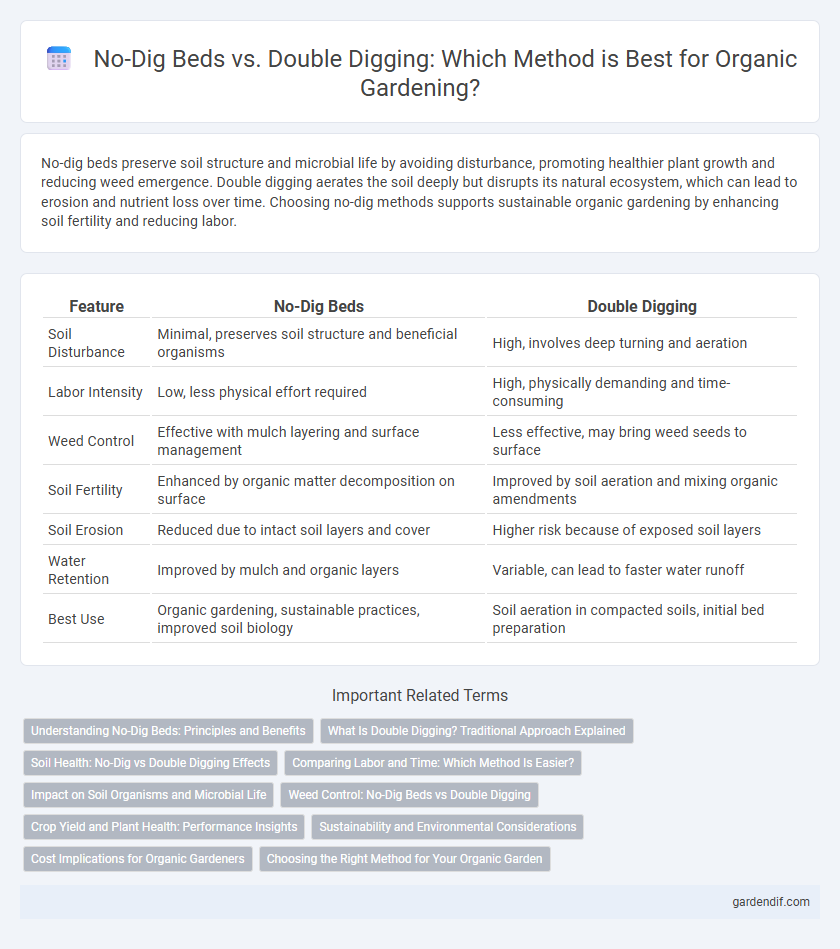
No-dig beds vs Double digging Illustration
No-dig beds preserve soil structure and microbial life by avoiding disturbance, promoting healthier plant growth and reducing weed emergence. Double digging aerates the soil deeply but disrupts its natural ecosystem, which can lead to erosion and nutrient loss over time. Choosing no-dig methods supports sustainable organic gardening by enhancing soil fertility and reducing labor.
Table of Comparison
| Feature | No-Dig Beds | Double Digging |
|---|---|---|
| Soil Disturbance | Minimal, preserves soil structure and beneficial organisms | High, involves deep turning and aeration |
| Labor Intensity | Low, less physical effort required | High, physically demanding and time-consuming |
| Weed Control | Effective with mulch layering and surface management | Less effective, may bring weed seeds to surface |
| Soil Fertility | Enhanced by organic matter decomposition on surface | Improved by soil aeration and mixing organic amendments |
| Soil Erosion | Reduced due to intact soil layers and cover | Higher risk because of exposed soil layers |
| Water Retention | Improved by mulch and organic layers | Variable, can lead to faster water runoff |
| Best Use | Organic gardening, sustainable practices, improved soil biology | Soil aeration in compacted soils, initial bed preparation |
Understanding No-Dig Beds: Principles and Benefits
No-dig beds preserve soil structure and microbiome by avoiding disruption, enhancing water retention and nutrient availability naturally. Organic matter is layered on top, promoting earthworm activity and fostering a healthy soil ecosystem that supports plant growth. This method reduces labor, prevents weed emergence, and improves long-term soil fertility compared to traditional double digging.
What Is Double Digging? Traditional Approach Explained
Double digging is a traditional gardening method involving the removal and deep loosening of two layers of soil to improve aeration, drainage, and root penetration. This technique contrasts with no-dig beds by disturbing the soil structure more extensively to incorporate organic matter and break up compaction. While effective for intensive cultivation, double digging requires significant labor and can disrupt soil ecosystems compared to the minimal disturbance in no-dig gardening.
Soil Health: No-Dig vs Double Digging Effects
No-dig beds preserve soil structure by minimizing disturbance, which supports beneficial microbial activity and enhances organic matter retention. In contrast, double digging aerates the soil but disrupts microbial ecosystems and can accelerate organic matter decomposition. Maintaining intact soil layers in no-dig methods promotes long-term soil health and nutrient cycling essential for organic gardening.
Comparing Labor and Time: Which Method Is Easier?
No-dig beds significantly reduce labor and time compared to double digging by eliminating the need for extensive soil overturning and deep digging. While double digging requires intense manual effort to aerate and improve soil structure, no-dig methods rely on layering organic mulches and compost to enhance soil health passively. Gardeners find no-dig beds easier and faster to establish, making them ideal for sustainable, labor-efficient organic gardening.
Impact on Soil Organisms and Microbial Life
No-dig beds preserve soil structure by minimizing disturbance, which supports diverse microbial communities and enhances habitat for beneficial soil organisms such as earthworms and fungi. In contrast, double digging disrupts soil layers and microbial networks, temporarily reducing microbial biomass and earthworm populations. Maintaining undisturbed soil in no-dig systems promotes long-term soil fertility and resilience through robust microbial activity and soil organism diversity.
Weed Control: No-Dig Beds vs Double Digging
No-dig beds naturally suppress weeds by maintaining a protective mulch layer and preserving soil structure, limiting weed seed germination. Double digging disrupts soil layers, which can inadvertently bring dormant weed seeds to the surface, increasing weed pressure. Consistent mulch application in no-dig systems supports long-term weed control by blocking sunlight and reducing weed seed viability.
Crop Yield and Plant Health: Performance Insights
No-dig beds maintain soil structure, promoting beneficial microbial activity that enhances nutrient availability and supports robust plant root development, leading to consistent or improved crop yields compared to double digging. Double digging can temporarily increase aeration and nutrient mixing but may disrupt soil ecosystems, potentially reducing long-term plant health and yield stability. Studies indicate that no-dig practices foster sustainable soil fertility and resilience, resulting in healthier plants and comparable or superior crop productivity over multiple growing seasons.
Sustainability and Environmental Considerations
No-dig beds enhance soil health by preserving its natural structure and promoting microbial biodiversity, which reduces erosion and carbon release compared to double digging. This method minimizes soil disturbance, leading to better water retention and decreased greenhouse gas emissions, aligning with sustainable organic gardening practices. Double digging disrupts soil layers, potentially harming beneficial organisms and accelerating organic matter breakdown, which can undermine long-term soil fertility.
Cost Implications for Organic Gardeners
No-dig beds reduce labor and tool expenses by eliminating the need for deep soil turning, making them cost-effective for organic gardeners. Double digging demands more time and physical effort, potentially increasing labor costs and requiring specialized tools or amendments to maintain soil health. Organic gardeners often find no-dig methods more sustainable in both financial and environmental terms, as they promote soil biodiversity and reduce the need for external inputs.
Choosing the Right Method for Your Organic Garden
No-dig beds preserve soil structure and microbial life, promoting healthier organic growth by minimizing disturbance, while double digging aerates soil deeply but risks disrupting beneficial organisms. Organic gardeners seeking sustainable, low-maintenance methods prefer no-dig systems that build fertility through layered compost and mulch. Evaluating soil condition and crop needs helps determine whether no-dig beds or double digging aligns better with organic principles for optimal plant health.
No-dig beds vs Double digging Infographic

 gardendif.com
gardendif.com